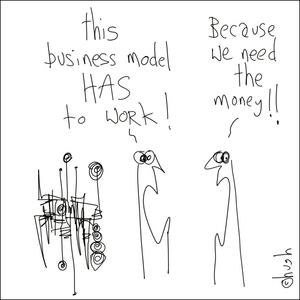This is the presentation to the talk I held at the 1. Mobile e-commerce conference / Apps Summit 2010 today in Wiesbaden, Germany:
Tag: scoreloop
![]() Apple has released an App Store Facebook app (which was aptly tagged with: “there’s a Facebook app for that”). This is a nifty move as it allows Apple a canvas from where to make discovery of apps as well as features and promotions somewhat easier.
Apple has released an App Store Facebook app (which was aptly tagged with: “there’s a Facebook app for that”). This is a nifty move as it allows Apple a canvas from where to make discovery of apps as well as features and promotions somewhat easier.
It is noteworthy though that Apple leaves its trusty closed environment (comprised of Apple hardware, iTunes at large and the App Store) to turn to another platform for help in resolving the increasing discovery dilemma. The (Facebook) app racked up over 85,000 in a few days already, which is already 10x the number the good folks of MPlayIt managed to assemble for their iPhone Arcade, which does similar things (and, yes, I am sure they won’t be too happy).
 It also highlights the increasing shift towards social discovery, and Facebook is – in my opinion (but then, and this is a disclaimer, given the work I do with Scoreloop, what do you expect?) only a first (albeit good) step: people care about what their friends say, play, do, recommend. And it is this community you need to unlock to get closer to access the social graph in ways that are meaningful to the single person. Where better to do it than from within a game or app though? 😉
It also highlights the increasing shift towards social discovery, and Facebook is – in my opinion (but then, and this is a disclaimer, given the work I do with Scoreloop, what do you expect?) only a first (albeit good) step: people care about what their friends say, play, do, recommend. And it is this community you need to unlock to get closer to access the social graph in ways that are meaningful to the single person. Where better to do it than from within a game or app though? 😉
But until then: good move, Apple!
 I will be setting off to San Francisco to seek out the geek fest that is GDC (or, to mere mortals, the Game Developers Conference).
I will be setting off to San Francisco to seek out the geek fest that is GDC (or, to mere mortals, the Game Developers Conference).
Scoreloop (for who I am doing some work as you will have found out by now), are throwing a party (with PocketGamer and MPlayIt) and you should let me know if you think you should be there but an invite has escaped you.
We have some exciting stuff to tell (some may have seen the podcast we did with Motorola and MySpace and there is more to come), so please get in touch (contact form) if you want to meet.
As a result, I may be a little silent over the next week or so. Bear with me…
 The term “Freemium” has been coined first a while ago by Union Square Ventures founder Fred Wilson and has been articulated further by Chris Anderson of Wired fame in his book “Free”. It has since attracted significant interest, last but not least because the concept seems to work… 😉
The term “Freemium” has been coined first a while ago by Union Square Ventures founder Fred Wilson and has been articulated further by Chris Anderson of Wired fame in his book “Free”. It has since attracted significant interest, last but not least because the concept seems to work… 😉
Ngmoco goes Freemium
Yesterday, Ngmoco, one of the new world’s (scil. Apple App Store’s) giants announced it raised another chunk of money ($25m to be exact) and acquired Freeverse, an iPhone developer that recently announced it had sold (sic!) more than 5m games, which are, alas, not always free – in the contrary. Together with this, Ngmoco announced a push into the Freemium model. So there we are…
 To recap: the company had released two titles so far under the Freemium model, namely Eliminate Pro and Touchpets. Both are rumoured to having done, well, OK in terms of revenue (although Ngmoco CEO Neil Young said they were clumsily made). They had previously acquired Miraphonic, makers of Epic Pet Wars and other games, and Neil wants to use the the combined forces of development power to push the Freemium model onto the iPhone properly. Good on him!
To recap: the company had released two titles so far under the Freemium model, namely Eliminate Pro and Touchpets. Both are rumoured to having done, well, OK in terms of revenue (although Ngmoco CEO Neil Young said they were clumsily made). They had previously acquired Miraphonic, makers of Epic Pet Wars and other games, and Neil wants to use the the combined forces of development power to push the Freemium model onto the iPhone properly. Good on him!
What is it about this Freemium?
The term describes games (or apps or services or whatever you can think of) that are initially free to use but use micro-transactions from within the game to monetise it. Eliminate Pro did this by selling Power Packs without which players needed to wait X hours before they could continue. Online, we have had other examples, e.g. Zynga’s Farmville where you can buy hard cash in order to immediately acquire items for which you would otherwise have to play hour after hour after hour. You get the gist… If interested, you should read Chris Anderson’s book since the underlying rationale does not only work in the little work of games.
The principle is simple and also compelling – from both the developer’s and the user’s side: the developer gets a shot at grabbing a multiple of eyeballs allowing for a multitude of chances to convince users that it is the real deal. Users get to look into the mystery bag before having to cough up hard cash. Win-win, you think.
And yes, it is: act honestly and transparently and you shall win over the hearts and minds of your users. IF your product is good and useful, the users will appreciate it, become fans (and maybe even fanatics) and will thus serve as your secondary sales force by recommending things to their friends who are much, much more likely to buy on the recommendation of their friends than from anyone else. What a wonderful idea.
Things to get right
There are two issues with this though, and it is important to get these right:
- Make sure to get the mechanics right. This does not work for any game or app or service. There must be some initial intrinsic and compelling value. Why would users otherwise use it? There must also be a good reason to buy. Why would users otherwise want to buy premium features? If you get it wrong (i.e. if too many users do not feel fairly treated), your users are gone. And what is the price of user acquisition? Yeah, you get it. It is MUCH more economical to treat users well; they will come back AND they will recommend you and your products.
- Make sure you get the balance right. Don’t be greedy, don’t be too tight. The aforementioned Eliminate Pro didn’t get the weighting right. The result was a) a couple of seriously upset users and b) sales that were not comparable to the top of the class (anecdotally, Eliminate Pro featured in the top-100 top-grossing list of Apple only very shortly). Remember that you need to deliver value; otherwise users – rightly – won’t feel properly treated but ripped off. And then? See above on customer acquisition costs.
The other side of balance is, however, that giving away too much will kill your business. And that is no good either.
Tools
There are tools to make your (the developer’s) life easier on this: create avenues of the players’ passion, make it easy for them to communicate their passion to their friends (which form the only community that truly matters to most of them) at a time when it is relevant to them, and you’re a big, big step closer to getting the principle right, which is to deliver value. Very, very few users will object to paying for value. But they will only do so (and in this fluid, transparent world more than ever) if the value is true and not some cheap glass pearls conceived to deceive.
Challenges, rewards, and incentives etc have shown to be powerful tools to spurn user activity. If you deliver value, there will not be hard feelings. If you want to learn more about available tools, get in touch…
The Power of Fanatics
74% of users buy things based on recommendations of friends. That is an astonishingly high number. If you manage to convert simple players into fanatics, you turn them into ambassadors and then you just need to do the maths: if the average iPhone user has 100 friends, you have a potential 74 sales (or free downloads with subsequent monetisation) per initial user. Woah!
Most importantly though: this approach does not alienate users. Why not? Because you delivered value. Deliver value and users will appreciate that (just ask Tony Hsieh, he just sold his company for $887.9m; he sells happiness, he says!).
Cartoon Credit: http://www.gapingvoid.com/thisbusinessmodel876-thumb.jpg
